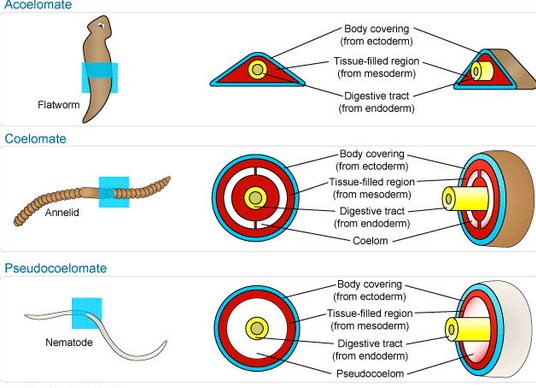For one thing, the fluid inside cushions the organs suspended within it, helping to prevent internal injuries. The cavity allows internal organs to grow and move independently of the outer body wall. For example, were it not for your coelom, your body surface would warp noticeably every time your heart beat or your intestines contracted. Coeloms also allowed animals to get bigger or at least thicker.
Fluids that move within the body cavity can serve the function of a circulatory system.
The body cavity can be used to store eggs. Open a female frog during breeding season and the eggs stored in the body cavity obscure the organs.
A fluid-filled cavity acts as a hydrostatic skeleton for soft-bodied animals. An animal’s body is made mostly of water, and water is incompressible. This means that animals with internal, water-filled cavities have the capacity to resist outside pressure and the pull of gravity, and so can maintain a constant body shape. Because a coelom or pseudocoelom acts as a hydrostatic skeleton and allows its possessor to resist external pressure, coelomates and pseudocoelomates can burrow and locomote very effectively, at least in environments that offers resistance to the hydrostatic skeleton.
Distinctions were made among animals based on the type of body cavity possessed.
There are a few triploblastic animals that completely lack any sort of body cavity. These animals are known as acoelomates.
Some animals possess a “false” coelom called a pseudocoelom. These animals are known as pseudocoelomates. A pseudocoelom is a body cavity that lies between mesodermal and endodermal tissue and is, therefore, not completely surrounded by mesodermal tissue.
A “true” coelom is completely surrounded by mesodermal tissue, and can thus be subdivided into compartments. Animals with a true coelom are known as eucoelomates or simply coelomates. Since mesoderm gives rise to muscle this means that in eucoelomates the muscles surrounding the gut are separate form the muscles near the outside or periphery of the body (the muscles controlling the appendages).
That digestion is no longer a function of the movement of the animal is the postulated advantage of a true coelom. Digestion could proceed at a constant or faster rate, supplying more energy to the animal, enabling it to go faster, or become larger. This is somewhat a biased vertebrate viewpoint. Other authors again looking at this type of coelom from a vertebrate viewpoint, feel a eucoelom can be divided more easily into sub compartments, allowing some isolation and better support between important organs or systems.

